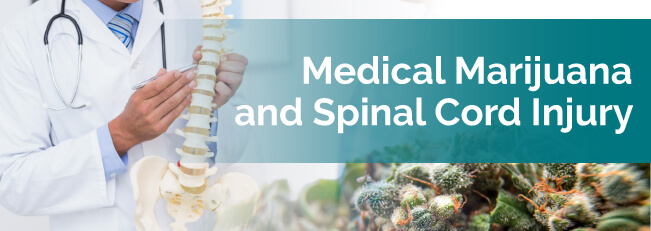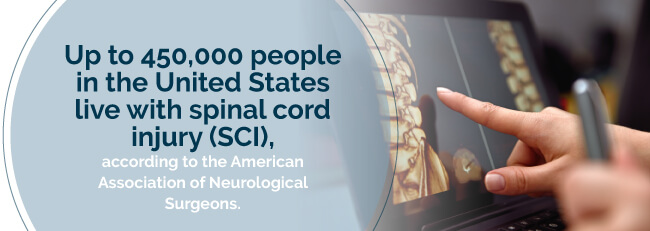
Up to 450,000 people in the United States live with spinal cord injury (SCI), according to the American Association of Neurological Surgeons. Around 11,000 cases of SCI occur each year in the U.S. Most of the cases are due to vertebral column trauma, which affects how the spinal cord sends and receives messages to the body’s systems from the brain and controls motor, autonomic and sensory function below the level of injury. With statistics like this, it’s no wonder patients are turning to treatments like medical marijuana for spinal cord injury due to the extreme pain it puts them in.

A spinal cord injury results in damage to your spinal cord. It’s a severe form of physical trauma, which can have a significant and lasting impact on most aspects of your everyday life, including your physical abilities and mental wellbeing.
Your spinal cord is made up of nerves and tissues your spine vertebrae contains and protects. Your vertebrae are bones stacked upon each other comprising your spine. Your spine has multiple nerves and extends from the base of your brain all the way down to your buttocks.
Your spinal cord sends messages to your brain. Because of these spinal cord messages, you’re able to move your limbs and perceive pain.
If your spinal cord sustains trauma, many of these signals — or all of them — can’t get through, resulting in a total or complete loss of mobility and sensation below the injury. If you have a spinal cord injury near your neck, it can cause paralysis throughout a more significant area of your body than an injury in your lower back area.
There are two general categories of spinal cord injuries. These are:
Knowing where your injury is and if it’s complete or incomplete can help you start researching your outcome so you can form educated questions for your doctor.
Spinal cord injury has been around since ancient times. Around 3000 B.C. in Egypt, the Edwin Smith surgical papyrus first described injury-related paraplegia of the spine.
Jason Lifshutz, M.D. and Austin Colohan, M.D. describe the history of SCI, spastic paralysis and their treatments in the journal Neurosurg Focus stating it dates back for thousands of years. SCIs have been debilitating for over a millennium.
In 1762, a surgeon, Andre Louis, removed a bullet from the lumbar spine of a patient, allowing the patient to regain motion in their legs later on.
Breakthroughs in health care, surgery, imaging and rehabilitation medicine, as well as substantial spinal cord injury improvement, didn’t occur until the most recent part of the century.
No matter what type of spinal cord injury you have, you may experience one or more of these symptoms:
Emergency symptoms of SCI after a trauma or accident may include:
Emergency symptoms require immediate medical attention.
Since spinal injuries can potentially cause long-term physical damage, you should always have a qualified medical professional examine them.
For instance, if you have a vertebral fracture resulting from an injury or trauma and you don’t seek treatment by a doctor, it can potentially lead to:
Your vertebrae are supposed to stay perfectly aligned. When you fracture a vertebra and it doesn’t properly heal, a deformity can occur, which may affect the shape of your spine. And this can cause a whole array of problems, including extreme pain.
Another example would be if you have an untreated herniated disc, it can lead to pain and severe nerve damage.
These are only two cases. Plenty of other spinal cord injuries require medical treatment.
Having to adjust to an SCI or disability is a lifetime process. Because of the pain and quality of life implications, you’re vulnerable to emotional disorders when you have a spinal cord injury.
Behavioral and emotional issues can develop or get worse after an SCI. Some things to consider are:
One study revealed the following mental effects among SCI patients:
If you’re dealing with an emotional disorder due to your spinal cord injury, you may benefit from psychological support. For instance, a psychiatrist could provide antidepressants or administer medical care. Medical marijuana may also help.
According to the World Health Organization (WHO):

Spinal cord injury treatment starts before you’re admitted to a hospital. Emergency medical personnel or paramedics immobilize your spine carefully at the accident or injury scene. Once you reach the emergency department, doctors maintain this immobilization as they identify and address other immediate life-threatening issues.
After your visit to the emergency department, you’ll likely be admitted to the hospital in the intensive care unit (ICU). Doctors may provide traction to align your spine correctly. Other forms of ICU care may include:
This type of care is essential to achieve the best outcome possible.
A treatment option for SCIs is intravenous (IV) methylprednisolone (Solu-Medrol, A-Methapred). You may experience mild improvement if doctors administer methylprednisolone within eight hours of your injury.
Methylprednisolone works by reducing nerve cell damage and inflammation near the injury site. It won’t cure your SCI, however.
Side effects of methylprednisolone may include:
There could be other side effects you should discuss with your doctor.
In many SCI cases, surgery is needed to remove bone fragments, herniated disks, foreign objects or fractured vertebrae compressing the spine. You may also require surgery to stabilize your spine to prevent deformity or pain later on.
Any surgery comes with some type of risks, including SCI surgery. Side effects may include:
You could end up with nerve damage leading to pain, weakness, sexual dysfunction, paralysis or loss of bladder or bowel control.
Your chances of something going wrong increase when you have certain health conditions.
Studies show cannabis effectively limits neurological damage when you use it shortly after your injury. It also helps manage muscle spasms and chronic pain. After a trauma, various pathological events can add to the spread of damage to your spinal cord, further provoking neurological losses.

But, administering medical marijuana’s cannabinoids shortly after your injury has been shown to delay degeneration and neuronal atrophy and reduce proinflammatory cytokines. This preserves the white matter surrounding the area injured and protects the myelin sheath surrounding the cord.
There are multiple benefits of marijuana for spinal cord injury including:
You also can’t become physically addicted to cannabis. However, there is the chance of a psychological addiction if you’re using it for its intoxicating effects. But, this doesn’t occur much with medical cannabis since it’s often higher in CBD, which has no psychoactive effects.
Medical weed not only eases your SCI side effects, but it may also even help your body repair itself. Researchers believe marijuana stimulates a neuroprotective response. Your endocannabinoid system plays a role in your spinal health and recovery, according to findings of a study. Early CB1 and CB2 receptor endogenous activation after an SCI is a protective response contributing to spontaneous recovery.
Scientists now know a lot about how marijuana works in the body. Cannabinoids activate certain receptors in your body, which produces pharmacologic effects, mostly in your immune system and central nervous system. When cannabis receptors in your pain-perception-regulating nervous system pathways are activated, you’ll experience a reduction in physical suffering.
Most individuals with SCI suffer from chronic pain, which is a serious problem plaguing those with spinal cord injuries. Chronic pain can last for months or years well after the initial SCI. It can negatively impact a person’s quality of life. People in severe pain aren’t able to carry out their day-to-day tasks in many cases.
Medical weed is well-known for its chronic pain fighting properties. One study published in The Journal of Spinal Cord Medicine showed that marijuana combined with massage provided SCI patients with the most effective pain relief.
Some side effects medical cannabis for spinal cord injury helps with include:
Unfortunately, since marijuana continues to be a schedule 1 drug, it is difficult for researchers to study medical marijuana for spinal cord injury.
Different weed strains might be more helpful for some SCI patients than others. Therefore, you’ll want to experiment on your own and work with your budtender and medical marijuana doctor. Below is a list of some strains you can try to treat your different spinal cord injury symptoms.
Strains for Spinal Pain
Strains for Muscle Spasms/Spasticity
Strains for Sleep
Strains for Anxiety and Depression
Strains for Stress
When you’re deciding on the strain you think is best for your SCI symptoms, you should also consider the times of the day you plan on using the treatment as well as the psychoactive level you’re comfortable with. For instance, sativa strains are good for daytime use while indicas you should save for night since they typically have high THC content in them. With hybrids, you’ll need to research the percentage of CBD vs. THC to determine when to use the strain.
Get your cannabis and spinal cord injury treatment through the following methods:
In a Journal of Pain-published human trial, researchers studied the use of vaporized marijuana for neuropathic pain in SCI patients. The results showed vaporized weed had more of a substantial analgesic response than a placebo.

Another small observational study with 15 participating patients showed the drug Sativex — an orally administered delta-9-THC-cannabidiol — benefits patients who suffer from SCI-related spasticity, and for whom other standard therapeutic methods didn’t help. However, this drug does need further research.
For those patients experiencing severe pain from their spinal cord injury, typically THC is needed, and as you may know, THC can cause euphoric or “high” feelings. If you don’t like the “high” feeling from THC, you can microdose with CBD and THC in drops using a tincture, allowing you to build your tolerance level up gradually — usually within days.
While these are helpful methods of marijuana and spinal cord injury treatment use for patients with these types of injuries, there are other methods you may want to try as well such as eating edibles, juicing fresh raw cannabis, using transdermal patches or even inserting suppositories. You can also go the old fashion way and simply smoke it.
For more information and to get your hands on medical cannabis and all its therapeutic effects, you’ll need a licensed marijuana doctor who can recommend the treatment to you. You’ll then have to get your medical marijuana card. So, search for a medical marijuana dispensary or find a doctor today.
Find A Doctor Find A Dispensary